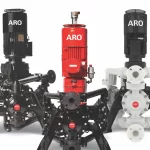PULSAtron pumps are electronic metering pumps, which simply means that an electronic circuit controls the charge and discharge of a solenoid driven diaphragm. A DC current energizes the solenoid pushing the diaphragm forward within the pump head for the discharge of fluid. When the current is removed, the solenoid de-energizes, allowing the diaphragm to retract (spring assisted), pulling more fluid into the pump head. The two main components to troubleshoot are therefore the solenoid and the circuit board.
The solenoid is simply a large winding of electrical conductor with a specific resistance. If this resistance is out of tolerance, then an improper current would result, impeding the proper operation of the pump. PULSAtron pumps have a distinct operating clack as the solenoid goes through its’ charge/discharge cycle and when absent, we know its’ time to troubleshoot. By removing the control panel (located in the rear of the pump), we can access the two wires connected to the circuit board to the solenoid. Power should be disconnected from the pump before removing the control panel! Remove these wires from the board by pulling on the connectors at the board (no tools required). Once removed, measure the resistance of the solenoid wires and if the reading is out of tolerance, the solenoid should be replaced.
If problems do occur and the solenoid is within specification, look to the circuit board. Since it is not practical to troubleshoot individual components on the circuit board, we discuss ways to identify circuit board problems in general, which are then addressed through replacement of the circuit board itself.
For Series E Plus models where a 4-20 mA input signal is utilized to control the pump flow rate and the pump is not responding to the 4-20 mA input signal, first make certain that the proper polarity connections have been made to the pump. The cable provided with the pump has a molded end which plugs into the 4-20 mA terminal on the pump (this terminal is marked on the pump). At the other end are two insulated conductors, white for positive and black for negative. If these conductors are reversed the pump will run at maximum stroking rate with no response to changes in the 4-20 mA input signal. If conductors are connected correctly and the unit fails to respond to changes in the 4-20 mA signal, the circuit board should be replaced.
For unit where External Pacing is an option, performance can be verified by shorting the two conductors at the end of the signal cable or by shorting the pins at the control panel (marked EXT). Each time the conductors or pins are shorted, the pump should stroke once. The circuit board on PULSAtron units has been designed to achieve the longest service life of any comparable product in the market. However, you can take simple measures to extend the service life even more. Make sure that all wiring is to code and try to avoid sharing electrical lines with high horsepower motors since the high energy level of induction motors can create voltage spikes which may result in circuit board damage. This can be prevented with the use of surge protectors or by isolating the pumps power source. Lastly, always minimize the stroke rate by operating the pump at full stroke length.








